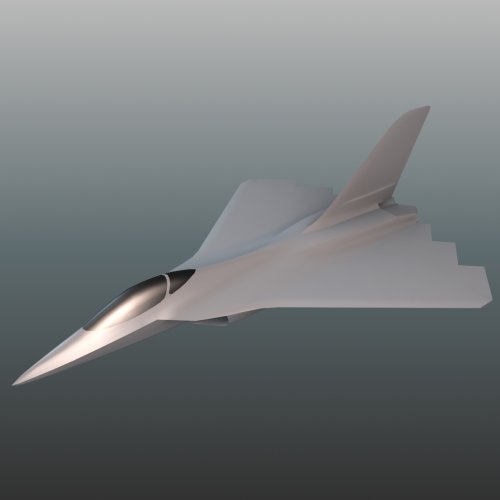The General Dynamics Design
The General Dynamics design for the dem/val phase evolved from a variety of inputs. During the previous program phase, the company had focused on three separate families of aircraft: conventional, all-wing, and semi-tailless (denoted in the configuration studies by C, W, and T, respectively). The conventional family derived from the Model 21 designs of the previous studies. The all-wing family strove to carry Sneaky Pete's minimum observables into the supersonic regime. The semi-tailless family, which had a single vertical tail, fell in between these two extremes. After a series of internal design competitions and trades, the company went with the semi-tailless approach.
The wing planform and airfoil design were chosen to minimize weight while providing the maximum turn capability and supersonic cruise. The single vertical tail, however, presented problems in achieving a totally stealthy design. General Dynamics ran many wind tunnel tests to find a location and shape for twin canted vertical tails on the T configuration. The vortex flow off the forebody and delta wing produced unstable pitching moments when it interacted with twin tails. Without horizontal tails, the aircraft did not have enough pitch authority to counteract these moments. A single vertical tail and no horizontal tails was finally identified as the best overall approach to the design despite the degradation of radar cross section in the side sector. The proposal configuration was designated T-330.
General Dynamics took a unique approach to the sensor requirements, using two radar arrays and one infrared search and track sensor. (Boeing and Lockheed had each used three arrays and two IRST sensors.) One IRST sensor was placed in the nose of the aircraft and the two radar arrays were located aft of the cockpit. The radar beam from each array could be steered sixty degrees from the face of the array, allowing each radar to cover the area from straight ahead to 120 degrees aft. The arrays were located just above the engine inlets.
General Dynamics configuration achieved a high state of detailed design. The company had built a full-scale mockup and was finalizing a half-size pole model for testing the design's radar cross section. Preliminary structural designs were developed, along with locations for manufacturing breaks to allow the aircraft to be divided among potential partners. General Dynamics had done well in the concept exploration phase of the program, placing very high in the field of seven. Among General Dynamics strengths were its extensive experience in fighter design and manufacturing gained in the F-16 program. The company also had experience with rapid prototyping: the YF-16 was an unsurpassed program in this respect.
F-22 Design Evolution
Reprinted article from Code One Magazine, April 1998, Vol.13 No.2

















